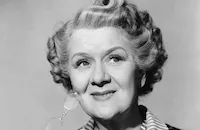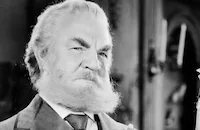Hard to Handle

Brief Synopsis
Cast & Crew
Mervyn Leroy
James Cagney
Mary Brian
Allen Jenkins
Ruth Donnelly
Claire Dodd
Film Details
Technical Specs

Synopsis
California promoter Myron C. "Lefty" Merrill is left holding the bag when his partner leaves town with the prize money for a marathon dance contest. Lefty is in love with the contest winner, Ruth Waters, but her widowed mother, Lil Waters, intends for her daughter to marry a rich man, not someone like Lefty. Determined to pay Ruth her share of the prize money, Lefty promotes a phony treasure hunt on the pier. He escapes with the entrance money just before a desperate mob destroys the pier looking for the promised prize, but learns that the Waters have left California for New York after illegally selling the furniture in their furnished apartment. Lefty follows the Waters east, where he discovers Ruth working as a model and dating wealthy fashion photographer John Hayden. After he watches Ruth struggle to rub in some sticky face cream, he imagines that all her efforts are burning calories and decides to promote it as a reducing cream. He solicits endorsements from society women and his campaign is extremely successful. Lil now considers Lefty to be a good match, but Ruth refuses to marry him until she knows how success will affect him. Lefty takes a job promoting a backwater college, and his success earns him an honorary degree and the attentions of student Marlene Reeves. Marlene's father, Charles, hires Lefty to promote Grapefruit Acres, a development in Florida. Lefty asks Ruth to accompany him and marry him there, but she refuses, saying that they will be married when he returns to New York. Later she and Lil decide to surprise Lefty in Florida, but they are surprised instead when they discover him having breakfast in Marlene's hotel room. After Lefty is arrested for false advertising because no one actually wants to buy grapefruit, he begins a campaign extolling the eighteen-day grapefruit diet, and soon the charges are dropped. Then when Lil tells him that Ruth is marry to Hayden, Lefty tricks her into admitting that she really loves him.

Director

Mervyn Leroy
Cast

James Cagney

Mary Brian

Allen Jenkins

Ruth Donnelly

Claire Dodd

Robert Mcwade

Gavin Gordon
Emma Dunn
John Sheehan
Matt Mchugh
Louise Mackintosh

Sterling Holloway

Berton Churchill
Harry Holman
Grace Hayle

Douglass Dumbrille

Walter Walker
Crew
Houston Branch
John Ellis
Leo F. Forbstein
Kenneth Green
Robert M. Haas
William Holmes
Howard E. Johnson
Robert Lord
Barney Mcgill
Wilson Mizner
Theodore F. Morse
Orry-kelly
C. A. Riggs
Charles Scott Welbourne
William Whitley

Photo Collections
Videos
Movie Clip



Trailer
Film Details
Technical Specs

Articles
Hard to Handle
Before the dispute Cagney had been slated to star in 20,000 Years in Sing-Sing (1933) but the film had already gone into production with Spencer Tracy in the lead role opposite Bette Davis, so he was rushed into Hard to Handle. Another problem was finding a leading lady. Carole Lombard, at that time under contract to Paramount, was approached to play the role of Cagney's girlfriend, the marathon dancer Ruth Waters. She turned it down. Instead, another Paramount star, Mary Brian, was hired and the brunette Brian was saddled with a blonde wig.
Then there was the writer Wilson Mizner. Known around Hollywood as one of that town's greatest wits, he had been a constant irritant for studio boss Jack Warner, who described Mizner in his autobiography as "playwright, adventurer, and lovable con man". Warner expected his writers, like all other studio employees, to arrive punctually at nine o'clock which Mizner never did. As Michael Freedland wrote in his book The Warner Brothers, "One of Jack's main targets was Wilson Mizner, a brilliant raconteur whom Warner was convinced was single-handedly robbing the studio tills of every penny taken at the box office. Mizner never seemed to produce anything, Jack announced one day and it was partly true, except that he came out with the best gags at the story conferences. "I don't pay anyone five hundred dollars a week for ad-libbing," he declared. "Do some work." Mizner's office was directly opposite Jack's. The day after the summary chastisement he could be seen sitting in the bright sunlight outside the office sharpening at least a hundred pencils. That, after all, was work." Cagney was especially fond of Mizner, saying "Some people are called characters and don't really merit the designation. Wilson Mizner was a genuine character, and great raconteur. We would go in for a story conference, but there'd be no conference. Everyone would just sit and listen to Wilson and all of it was delightful." Sadly, Mizner died of a heart attack at the age of fifty-eight on April 3, 1933, only two months after Hard to Handle was released.
The story of a press agent who'll promote anything and anyone suited Cagney well after having played a string of gangsters, something that always bothered the actor who always saw himself as a song-and-dance man. An allusion is made to Cagney's earlier role in The Public Enemy (1931) which made him famous when he smashed a grapefruit half into Mae Clarke's face. In Hard to Handle, he is called upon to promote grapefruit, complete with a song composed by Warren and Dubin called "Grapefruit Acres" which can be heard on the radio during the film.
Hard to Handle wasn't an important film for Cagney other than marking the beginning of his salary increase, but the reviews were positive. Mordaunt Hall titled his New York Times review from February 2, 1933 "Hard to Handle James Cagney, Alert and Fiery as Ever; Impersonates a Dynamic Publicity Agent in New Film". Hall wrote, "James Cagney's shadow burst into Warner's Strand [Theatre] last night as the dynamic publicity man in Hard to Handle, an adaptation of a story by Houston Branch. It is a violent, down-to-the-pavement, slangy affair which has many a mirthful moment...Mr. Cagney as Lefty Merrill leaps from the frying pan into the fire, from the fire into the frying pan and lastly from the pan to the kitchen floor...The episodes fly by like the wind, or as fast as Lefty Merrill runs in several of the episodes...And like virtually all Mr. Cagney's pictures, there is no time for pausing. The picture must go on, and on it goes."
Director: Mervyn LeRoy
Screenplay: Robert Lord and Wilson Mizner; Houston Branch (story)
Cinematography: Barney McGill
Art Direction: Robert M. Haas
Music: Cliff Hess (uncredited)
Film Editing: William Holmes
Cast: Myron C. 'Lefty' Merrill (James Cagney), Ruth Waters (Mary Brian), radio announcer (Allen Jenkins), Lil Waters (Ruth Donnelly), Marlene Reeves (Claire Dodd), Charles G. Reeves (Robert McWade).
BW-79m.
by Lorraine LoBianco
Sources:
James Cagney by Doug Warren
Hard to Handle: James Cagney, Alert and Fiery as Ever; Impersonates a Dynamic Publicity Agent in New Film by Mordaunt Hall, The New York Times February 2, 1933
The Warner Brothers by Michael Freeland
My First Hundred Years in Hollywood by Jack Warner

Hard to Handle
Quotes
Trivia
Notes
The film's pre-release titles were The Inside and Bad Boy. According to Film Daily, Carole Lombard was considered for the role which Mary Brian played. Contemporary sources all note James Cagney's promotion of Grapefruit Acres as a joke referring to the famous scene in which he hits Mae Clarke with a grapefruit in Public Enemy. The film was shot over thirty-one days and was made for a total cost of $189,000. Modern sources add to the crew credits: Makeup artist Perc Westmore; and to the cast credits: William H. Strauss (Antique dealer), Bess Flowers (Merrill's secretary), Lew Kelly (Hash-slinger), George Pat Collins (Dance judge), and Jack Crawford, Stanley Smith, and Mary Doran.















